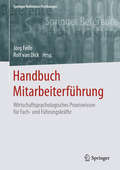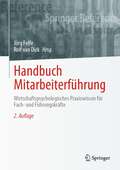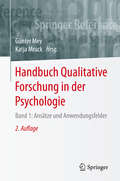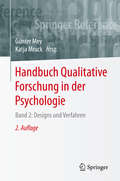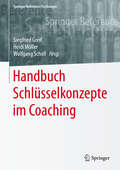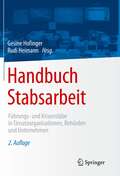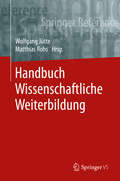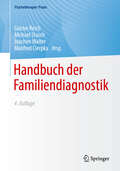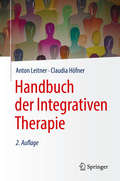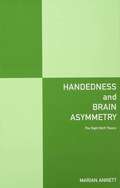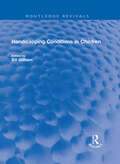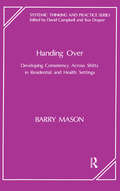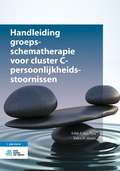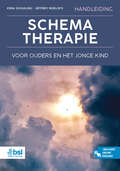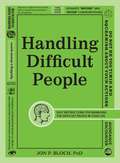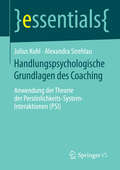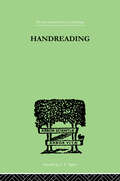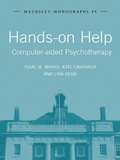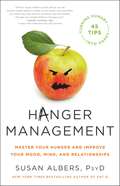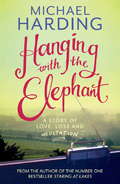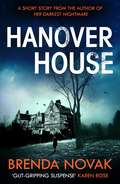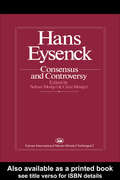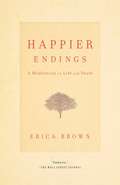- Table View
- List View
Handbuch Mitarbeiterführung
by Rolf Van Dick Jörg FelfeDieses Praxishandbuch ist ein Nachschlagewerk zum Thema Mitarbeiterführung und richtet sich an alle, die sich für die konkrete Umsetzung von Führungswissen in der Praxis interessieren. Dieses Umsetzungswissen ist von besonderer Bedeutung für Führungskräfte und solche, die es werden wollen. Aber auch Trainer, Berater, Coaches, Personalentwickler und Studierende der Psychologie und der Wirtschafts- und Sozialwissenschaften profitieren von den anschaulich geschriebenen Beiträgen, die kein spezifisches Fachwissen voraussetzen, und erhalten einen hervorragenden Überblick über den aktuellen Stand der Forschung. Die praktische Anwendung des Wissens steht hierbei im Mittelpunkt. Die Beiträge wurden von ausgewiesenen Experten aus dem deutschsprachigen Raum verfasst. In 27 Kapiteln ist das aktuelle Wissen zu modernen Theorien guter Führung (z.B. ethische oder authentische Führung), zu gesundheitsförderlicher Führung oder zum Management von (alters)diversen Gruppen praxisnah aufbereitet. Auch zu wichtigen und aktuellen Themen wie Coaching, Ex- und Repatriates oder zu „Jung führt alt“ sind Beiträge enthalten. Alle Beiträge sind einheitlich strukturiert und anhand einer Kurzzusammenfassung schnell zu überblicken. Sie beginnen mit einem Fallbeispiel, auf dessen Problemstellung Antworten gegeben werden. Je nach Thema enthalten die Beiträge zudem direkt einsetzbares Zusatzmaterial, wie Checklisten, Leitfäden, Trainingskonzepte oder Instrumente. Die Beiträge liefern der Praxis neue Impulse und können dort unmittelbar genutzt werden.
Handbuch Mitarbeiterführung: Wirtschaftspsychologisches Praxiswissen für Fach- und Führungskräfte
by Rolf Van Dick Jörg FelfeDieses Praxishandbuch ist das erweiterte und aktualisierte Nachschlagewerk zum Thema Mitarbeiterführung und richtet sich an alle, die sich für die konkrete Umsetzung von Führungswissen in der Praxis interessieren. Dieses Umsetzungswissen ist von besonderer Bedeutung für Führungskräfte und solche, die es werden wollen. Aber auch Trainer, Berater, Coaches, Personalentwickler und Studierende der Psychologie und der Wirtschafts- und Sozialwissenschaften profitieren von den anschaulich geschriebenen Beiträgen, die kein spezifisches Fachwissen voraussetzen, und erhalten einen hervorragenden Überblick über den aktuellen Stand der Forschung. Die praktische Anwendung des Wissens steht hierbei im Mittelpunkt. Die Beiträge wurden von ausgewiesenen Experten aus dem deutschsprachigen Raum verfasst. In ca. 50 Kapiteln ist das aktuelle Wissen zu modernen Theorien guter Führung (z.B. ethische oder authentische Führung), zu gesundheitsförderlicher Führung oder zum Management von (alters)diversen Gruppen praxisnah aufbereitet. Alle Beiträge sind einheitlich strukturiert und anhand einer Kurzzusammenfassung schnell zu überblicken. Sie beginnen mit einem Fallbeispiel, auf dessen Problemstellung Antworten gegeben werden. Je nach Thema enthalten die Beiträge zudem direkt einsetzbare Checklisten, Leitfäden, Trainingskonzepte oder Instrumente. Alle Beiträge können in der Praxis unmittelbar genutzt werden.
Handbuch Qualitative Forschung in der Psychologie: Band 1: Ansätze und Anwendungsfelder
by Günter Mey Katja MruckQualitative Forschung und ihre Methoden sind ein wichtiger Zugang im Rahmen psychologischer Erkenntnissuche. Während qualitative Herangehensweisen in benachbarten Wissenschaftsfeldern zum Standardrepertoire gehören, ist diese Tradition in der Psychologie über Jahrzehnte vernachlässigt worden. Die Erstauflage aus dem Jahr 2010 hat eine Wende eingeleitet. Die Neuauflage mit 70 Beiträgen erscheint in zwei Bänden und steht für die Etablierung und Weiterentwicklung einer qualitativen Psychologie. In Band I werden zentrale Positionen vorgestellt, die eine theoretische Fundierung für qualitative Forschung in der Psychologie bieten. Im Anschluss wird eine Vielzahl an Anwendungsfeldern und subdisziplinären Arbeitsgebieten behandelt.
Handbuch Qualitative Forschung in der Psychologie: Band 2: Designs und Verfahren
by Günter Mey Katja MruckQualitative Forschung und ihre Methoden sind ein wichtiger Zugang im Rahmen psychologischer Erkenntnissuche. Während qualitative Herangehensweisen in benachbarten Wissenschaftsfeldern zum Standardrepertoire gehören, ist diese Tradition in der Psychologie über Jahrzehnte vernachlässigt worden. Dieses Handbuch steht im Zeichen eines Wechsels. Namhafte Expertinnen und Experten setzen Psychologie und qualitative Forschung in Beziehung, beschreiben ihre Methoden und Herangehensweisen und liefern in 60 Beiträgen einen breiten Überblick über den Stand der qualitativen psychologischen Forschung im deutschsprachigen Raum.
Handbuch Schlüsselkonzepte im Coaching
by Heidi Möller Wolfgang Scholl Siegfried GreifDieses Handbuch widmet sich den wissenschaftlichen Grundlagen des Coachings und zeigt deren Anwendungsmöglichkeiten anhand praktischer Beispiele auf. Damit liefert es insbesondere Coaches und Coachingausbildungen fundiertes Fachwissen als Fundament für ihre Profession. Wissenschaftler/innen finden einen aktuellen Überblick über den Stand der Forschung. Mit 70 Beiträgen ausgewiesener Fachexperten/innen verschiedener Länder und Disziplinen zu grundlegenden Schlüsselkonzepten im Coaching ist dieses Handbuch ein einzigartiges Referenzwerk. Die Beiträge beschreiben die praktische Anwendung des Wissens und beginnen dazu in der Regel mit einem Fallbeispiel aus dem Coaching.
Handbuch Stabsarbeit: Führungs- und Krisenstäbe in Einsatzorganisationen, Behörden und Unternehmen
by Gesine Hofinger Rudi HeimannStabsarbeit effizient und effektiv gestalten!Diese erweiterte, komplett überarbeitete Neuauflage des Handbuchs zur Stabsarbeit bietet einen anwenderorientierten Überblick über die Arbeit von Führungs- und Krisenstäben, ihre Voraussetzungen und Erfolgsbedingungen. Basierend auf der Expertise eines interdisziplinären Autorenteams erhalten Sie alle wichtigen Grundlagen, Prozesse und Strategien der Stabsarbeit zur Bewältigung komplexer Schadenslagen oder Einsatzsituationen. Zudem werden Fallbeispiele aus verschiedenen Bereichen vorgestellt.Zum InhaltGrundlagen der Stabsarbeit: Konzepte, Formen, Historie und ethische AspekteStabsarbeit in den Bereichen Militär, Polizei, Feuerwehr, Katastrophenschutz, Störfall- & Prozessindustrie, Verwaltung, Unternehmen, Krankenhaus, Schule und PolitikFühren und Entscheiden im Stab: Planung und Kontrolle, Lagebesprechungen, Beurteilen, Entscheiden und Entscheidungshilfen, Stress und StressbewältigungKommunikation und InformationsflüssePersonalauswahl, Ausbildung und Training von StäbenKonzepte und Gestaltung von StabsräumenSchnittstellen zwischen verschiedenen Stäben und FunktionenFallbeispiele aus der Praxis von KrisenstäbenDie ZielgruppenPersonalleitungen und Führungskräfte, Stabsmitglieder und Entscheider an der Spitze eines Stabes aus behördlichen oder privatwirtschaftlichen Bereichen, Verantwortliche im Katastrophenschutz, Notfall- und Krisenmanagement.Die HerausgeberDr. Gesine Hofinger ist Diplom-Psychologin, Partnerin von Team HF – Human Factors Forschung Beratung Training sowie wissenschaftliche Mitarbeiterin an der Universität Jena. Sie forscht im Bereich Bevölkerungsschutz und publiziert zu Stabsarbeit und Human-Factors-Psychologie. Sie bildet Krisenstäbe aus, ist an der Durchführung und Beobachtung von Stabsübungen aktiv beteiligt und führt After Action Reviews mit Stäben durch. Sie ist Vorsitzende der Plattform „Menschen in komplexen Arbeitswelten“ e. V.Rudi Heimann ist Polizeivizepräsident, zuvor Leiter einer zentralen Ausländerbehörde und in unterschiedlichen Führungsfunktionen in der hessischen Polizei tätig, währenddessen Polizeiführer und Leiter Führungsstab. Lehrtätigkeit in Kriminologie, Führungslehre und polizeiliches Einsatzmanagement an der Fachhochschule der Polizei in Hessen sowie Gastdozent u. a. an der Deutschen Hochschule der Polizei. Kommentierung der bundesweiten PDV 100 VS-NfD- Führung und Einsatz der Polizei. Spezialisiert auf Entscheidungsfindung und Stabsarbeit. Zahlreiche Publikationen mit Themenbezug. Vorstandmitglied der Plattform „Menschen in komplexen Arbeitswelten“ e. V.
Handbuch Stress und Kultur: Interkulturelle und kulturvergleichende Perspektiven
by Frederick T. L. Leong Petia Genkova Tobias RingeisenDas Handbuch fasst den Forschungsstand zum Zusammenhang von Kultur, Stress und Gesundheit zusammen. Das Besondere ist dabei, dass sowohl kulturvergleichende als auch interkulturelle Ansätze berücksichtigt und ihre Wechselwirkungen betont werden. Insgesamt 45 Kapitel greifen aktuelle Fragestellungen aus Theorie und Praxis auf und stellen zugehörige Betrachtungsebenen, Untersuchungsmethoden und Forschungsergebnisse dar. Themen umfassen z.B. (gesundheits)psychologische Implikationen von Migration, Forschungsmethoden für kulturvergleichende und interkulturelle Fragestellungen oder Stress(bewältigung) in multikulturellen Settings. Für die zweite Auflage wurden die Bereiche „Stress und Gesundheit im Kontext Migration und Flucht“ sowie „Stress und Gesundheit in interkulturellen Bildungssettings“ mit insgesamt 13 Beiträgen neu aufgenommen. Die Beträge der anderen vier Bereiche wurden aktualisiert und grundlegend überarbeitet. Ergänzend sind eine Vielzahl neuer Kapitel hinzugekommen. Neue Inhalte umfassen z.B. die gesundheitsbezogenen Folgen von Flucht und Migration, kultursensible Methoden zur Datenerhebung oder Ansätze zum Umgang mit Stress in ausgewählten interkulturellen Settings.
Handbuch Wissenschaftliche Weiterbildung
by Matthias Rohs Wolfgang JütteDas Handbuch systematisiert erstmals umfassend das Feld der Wissenschaftlichen Weiterbildung. Beiträge ausgewiesener Fachexpertinnen und Fachexperten beleuchten den aktuellen Informations- und Forschungsstand. In der Darstellung und Diskussion der Handlungsfelder und Gegenstände bietet das Handbuch sowohl eine grundlegende Einführung in die Wissenschaftliche Weiterbildung als auch eine Gegenwartsbeschreibung der Weiterbildung an Hochschulen als Ausgangspunkt für die weiterführende Entwicklung in Forschung und Weiterbildungspraxen.
Handbuch der Familiendiagnostik (Psychotherapie: Praxis)
by Manfred Cierpka Günter Reich Michael Stasch Joachim WalterMit diesem komplett überarbeiteten Handbuch können Psychotherapeutinnen und Psychotherapeuten den diagnostischen Prozess in der Arbeit mit Familien Schritt für Schritt nachvollziehen. Vom ersten Telefonkontakt über die Durchführung der Gespräche bis hin zur klinischen Dokumentation: Dieses Buch enthält alle Fakten und Informationen für Ihre tägliche Arbeit. Ein Leitfaden für die Gesprächsführung unterstützt Sie praktisch. Beispiele illustrieren und erläutern den theoretischen Hintergrund. Der interdisziplinäre Ansatz gewährleistet, dass systemische, psychoanalytische, strukturelle und verhaltenstherapeutische Konzepte zur Anwendung kommen. Von den Grundlagen über Therapieverfahren bis hin zu speziellen Situationen werden alle Aspekte der Familiendiagnostik in ihrer praktischen Anwendung dargestellt. Aus dem Inhalt: Grundlagen – Familienerstgespräch: Vorbereitung, Durchführung, Auswertung, Beispiel – Die diagnostischen Fenster – Besondere Aspekte und Techniken der Familiendiagnostik – Empirisch-diagnostische Methoden. Die Herausgeber: Prof. Dr. Günter Reich, ehem. Leitender Psychologe, Universitätsmedizin Göttingen, Klinik für Psychosomatische Medizin und Psychotherapie. Michael Stasch, Dipl.-Psych., Psychoanalytiker und Familientherapeut, Heidelberg. Dr. Joachim Walter, Chefarzt Kinder- und Jugendpsychiatrie, Katholisches Kinderkrankenhaus Wilhelmstift, Hamburg. Prof. Dr. med. Manfred Cierpka (+), Facharzt für Psychotherapeutische Medizin, Psychoanalytiker und Familientherapeut, Heidelberg.
Handbuch der Integrativen Therapie
by Claudia Höfner Anton LeitnerDie Integrative Therapie verbindet bewährte Psychotherapiekonzepte mit Erkenntnissen der Evolutions- und Neurobiologie sowie mit kulturellen, historischen und philosophischen Orientierungen. Der Autor, Wegbereiter der Integrativen Therapie in Österreich, liefert einen umfassenden Überblick zu dem neuen Ansatz und skizziert die Therapie als klinisches, wissenschaftsgestütztes psychotherapeutisches Verfahren. Dabei berücksichtigt er insbesondere forschungsbasierte therapeutische Wirkfaktoren. Der Band enthält zahlreiche Fallbeispiele.
Handedness and Brain Asymmetry: The Right Shift Theory
by Marian AnnettBrain asymmetry for speech is moderately related to handedness but what are the rules?Are symmetries for hand and brain associated with characteristics such as intelligence, motor skill, spatial reasoning or skill at sports?In this follow up to the influential Left, Right Hand and Brain (1985) Marian Annett draws on a working lifetime of research to help provide answers to crucial questions. Central to her argument is the Right Shift Theory - her original and innovative contribution to the field that seeks to explain the relationships between left-and right-handedness and left-and right-brain specialisation. The theory proposes that handedness in humans and our non-human primate relations depends on chance but that chance is weighted towards right-handedness in most people by an agent of right-hemisphere disadvantage. It argues for the existence of a single gene for right shift (RS+) that evolved in humans to aid the growth of speech in the left hemisphere of the brain.The Right Shift Theory has possible implications for a wide range of questions about human abilities and disabilities, including verbal and non verbal intelligence, educational progress and dyslexia, spatial reasoning, sporting skills and mental illness. It continues to be at the cutting edge of research, solving problems and generating new avenues of investigation - most recently the surprising idea that a mutant RS+ gene might be involved in the causes of schizophrenia and autism.Handedness and Brain Asymmetry will make fascinating reading for students and researchers in psychology and neurology, educationalists, and anyone with a keen interest in why people have different talents and weaknesses.
Handicapping Conditions in Children (Routledge Revivals)
by Bill GillhamFirst published in 1986, Handicapping Conditions in Children provides an accessible overview of a wide range of handicapping conditions and their remediation, and gives a balanced perspective on the medical, educational and social issues. It will therefore be of value to a wide audience in these professions as well as to students and parents. Each chapter deals with one specific area but is presented to cover: description of the condition and its aetiology; its prevalence in the population and relatives; developmental characteristics; special problems and needs; educational and social provision; the potential for the future; and further reading lists. The book does not include every possible condition, but concentrates on those that are most frequent or problematic. This book is a reissue originally published in 1986. The language used is a reflection of its era and no offence is meant by the Publishers to any reader by this republication
Handing Over: Developing Consistency Across Shifts in Residential and Health Settings
by Barry MasonThis book is about that idea and how it can be used to develop consistency across shifts in residential and health settings. It demonstrates that passing information productively from one shift to another is not about the information itself, but about the context in which the passing takes place.
Handleiding groepsschematherapie voor cluster C-persoonlijkheidsstoornissen
by Eelco H. Muste Edith E.M.L. TjoaDit boek biedt behandelaren in de ggz een behandelprotocol voor schematherapie bij cluster C-persoonlijkheidsproblematiek. Het protocol is ontwikkeld voor groepsschematherapie, maar is ook toepasbaar voor individuele therapie. Daarnaast is het goed toepasbaar bij chronische problematiek. Cluster C-persoonlijkheidsstoornissen komen frequent voor, bij 3 tot 9 % van de algemene bevolking. Bij ongeveer de helft van de stemmings-, angst- en eetstoornissen is er ook sprake van comorbide cluster C-problematiek. In Handleiding groepsschematherapie voor cluster C-persoonlijkheidsstoornissen wordt de behandeling helder beschreven. Het laat duidelijk de structuur en de focus van de sessies zien en welke oefeningen hierbij gebruikt kunnen worden. Gewerkt wordt met het modusmodel van schematherapie; een heel herkenbaar model voor cliënten, dat de behandeling snel concreet maakt.De in dit boek beschreven behandelvorm met dertig sessies is wetenschappelijk onderzocht met een pilotonderzoek in verschillende instellingen in Nederland. Hierbij is aangetoond dat er een zeer lage drop-out is en dat therapeuten en cliënten enthousiast zijn over de vorm van de behandelsessies. De eerste resultaten m.b.t. de persoonlijkheidsproblematiek tonen een positieve trend. Dit ondanks de vaak hardnekkige problematiek, die klachten als angststoornissen, eetstoornissen en depressies in stand houdt.Groepsschematherapie voor cluster C-persoonlijkheidsstoornissen bestaat uit een handleiding voor de therapeut en een werkboek voor de cliënt. Tegen het einde van de behandeling wordt de cliënt steeds meer zijn eigen therapeut en bepaalt hij zelf welk huiswerk in de laatste fase passend is.“Ik was bij de start echt wat sceptisch over de lengte van de therapie en vroeg me af of we het wel gingen redden met alle wisselingen in de groep. Ik was dan ook positief verrast over wat het voor cliënten kon betekenen. Het vraagt enige inzet en draagkracht van de cliënt, maar het is verrassend wat deze ervaringsgerichte therapie kan doen en betekenen voor cliënten met (soms complexe) vermijdende persoonlijkheidsproblematiek."Berdien Henniphof, GZ-psycholoog, De Viersprong
Handleiding schematherapie voor ouders en het jonge kind
by Jeffrey Roelofs Esra SchuilingDit boek helpt therapeuten stap voor stap gezinsgerichte schematherapie te geven. Het boek is primair bedoeld voor therapie bij ouders met jonge kinderen (0-5 jaar), maar de oefeningen in het boek kunnen net zo goed toegepast worden bij ouders van oudere kinderen in andere ontwikkelingsfasen. Deze behandelmethode is zowel toepasbaar bij groepstherapie als individuele therapie. Bij dit therapeutenboek hoort een apart werkboek voor ouders. Handleiding schematherapie voor ouders en het jonge kind biedt een duidelijk theoretisch kader voor gezinsgerichte schematherapie voor ouders in de fase van pril ouderschap. Dat doet het aan de hand van het ontstaan van vroegkinderlijk onaangepaste schema’s, met de basisbehoeften van ouder en kind als rode draad. Het boek beschrijft helder, concreet en met veel casuïstiek het protocol voor ouders met persoonlijkheidsproblematiek. Het boek bespreekt verschillende toepassingen van schematherapie voor ouders die is gericht op het doorbreken van intergenerationele hechtingsproblematiek. Ten slotte staat het ook stil bij de mogelijke valkuilen en moeilijkheden van schematherapie voor ouders. Daarmee is het een geschikte therapie voor alle (aanstaande) ouders en gezinnen – in welke vorm dan ook.
Handling Difficult People: Easy Instructions for Managing the Difficult People in Your Life
by Jon P BlochPractical advice for interacting with toxic personalities.At one point or another, you'll encounter someone who is inconsiderate, irate, or aggressive and you'll need to know how to effectively manage the situation. Handling Difficult People helps you deal with the toxic personalities in all areas of your life, including in the workplace, at home, and during everyday interactions. Inside, you'll find the strategies and tools you need to spot the ten most common personality types and information on why these people behave in such an irritating manner. This book also teaches you what you should do when you're confronted by a difficult person as well as how to avoid these types of people altogether.With the time-tested advice and techniques in Handling Difficult People, you'll confidently manage any toxic situation--and learn what you can do to help yourself.
Handling Difficult People: How to recognize, analyze, approach, and deal with difficult people
by Jon P BlochLet’s face it: Some people rub you the wrong way. It could be something they do, something they don’t do—or you may not be able to put your finger on it. Handling Difficult People is an engaging, easy-to-read reference full of examples to aid you in dealing with the troublesome people in your life. With this practical guide, you’ll develop the skills you need to handle anyone in any situation…and come out on top.
Handlungspsychologische Grundlagen des Coaching: Anwendung der Theorie der Persönlichkeits-System-Interaktionen (PSI) (essentials)
by Julius Kuhl Alexandra StrehlauCoaching fördert die Entwicklung der Selbststeuerungsfähigkeiten des Klienten, die für die Lösung eines Problems oder die Erreichung eines (meist) beruflichen Ziels bedeutsam sind. In diesem Beitrag wird die Persönlichkeits-System-Interaktions-Theorie (PSI-Theorie) dargestellt, mit der verschiedene Persönlichkeitstheorien, wissenschaftliche Befunde und neurobiologische Grundlagen zu einer Theorie der willentlichen Handlungssteuerung verbunden werden. Mit Hilfe der PSI-Theorie können nicht nur Prozesse der Selbststeuerung theoretisch erklärt werden, sondern sie bietet auch eine Grundlage dafür, das professionelle Handeln im Coaching systematisieren und definieren zu können.
Handreading: A STUDY OF CHARACTER AND PERSONALITY
by Laffan, M NFirst Published in 1999. Routledge is an imprint of Taylor & Francis, an informa company.
Hands-on Help: Computer-aided Psychotherapy (Maudsley Series)
by Kate Cavanagh Isaac M. Marks Lina GegaHands-on Help is a narrative review of the mushrooming field of computer-aided psychotherapy for mental health problems as a whole, from the time it began in the 1960’s through to the present day. The many types of computer-aided psychotherapy and how each might be accessed are detailed together with the pros and cons of such help and the functions it can serve. The authors review prevention as well as treatment. The book describes and summarizes 97 computer-aided self-help systems in 175 studies according to the types of problem they aim to alleviate. These include phobic, panic, obsessive-compulsive and post-traumatic disorders, depression, anxiety, eating disorders, sexual problems, smoking, alcohol and drug misuse, schizophrenia, insomnia, pain and tinnitus distress, and childhood problems such as encopresis, autism and asthma. Within each type of problem the systems are described according to whether they are used on the internet, CD-ROM, phone, handheld or other device. The final chapter shows how internet self-help systems with phone or email support allow clinics to become more virtual than physical. It also discusses methods of screening suitability and of supporting users, constraints to delivery, uptake and completion, cost-effectiveness, and the place of computer-aided self-help in healthcare provision. This informative book will be essential reading for psychiatrists, psychologists and all other mental health professionals interested in broadening their understanding of computer-aided psychotherapy.
Hanger Management: Master Your Hunger and Improve Your Mood, Mind, and Relationships
by Susan AlbersThe complete program for mastering your "hanger," from mindful-eating pioneer Dr. Susan Albers -- with 45 tips to turn hanger into happiness. It happens to all of us. One minute you're happily going about your day, and a few seconds later you're a snappy, illogical version of yourself. The culprit? Hanger. We're living busier lives than ever before, and when we forget to eat -- or accidentally overeat -- hunger can make us angry, unreasonable, and dull, with big impacts on our emotional and psychological well being. And hanger can become a cycle. When we get too hungry, we're more likely to make food decisions we regret, which sets us up for another hanger crash later on. The good news: when we make better decisions about food, we think more clearly, connect better in our relationships, and improve our performance. Hanger Management is the book that can help you break this cycle and create healthy habits that fuel and empower you.In Hanger Management, New York Times bestselling author and clinical psychologist Susan Albers sheds light on the causes of hanger, and shares 45 of her best tips for managing it well. By learning to stay on top of your hunger cues, cultivating a better understanding of your appetite, and creating a better overall relationship with food, you'll become happier -- and healthier -- for life.
Hanging with the Elephant: A Story of Love, Loss and Meditation
by Michael HardingIn his new book, Hanging with the Elephant, writer Michael Harding is back in Leitrim in the north-west of Ireland. His wife has left for a six-week trip to Poland and he is alone for the first time since his illness two years earlier. Faced with this time on his own, Harding resolves to examine the threat of depression that is a constant presence in his life and his dependency on his wife, the beloved, since his illness. But, as he attempts to tame the 'elephant' - an Asian metaphor for the unruly mind - he finds himself drawn back to the death of his mother during the summer of 2012. Written with unflinching honesty, Hanging with the Elephant begins as one man's quest to overcome his demons, but becomes a journey into the depths of the soul, where we are given a glimpse of the one thing that holds us all.
Hanover House: (Evelyn Talbot series, Book 0.5) (Evelyn Talbot)
by Brenda NovakThis is SILENCE OF THE LAMBS meets Karen Rose...The stunning prequel to New York Times bestseller Brenda's Novak latest thriller Her Darkest Nightmare, described as 'gut-gripping suspense' by Karen Rose, introduces new series lead Dr Evelyn Talbot. Welcome to Hanover House...Psychiatrist Evelyn Talbot has dedicated her life to analysing psychopaths. Why they act as they do. How they come to be. Why they don't feel remorse. Her only goal is to use her knowledge to find and stop them. Having been tortured and left for dead when she was just a teenager by her high school boyfriend, Evelyn's determined to understand how someone she trusted so much could turn on her. Establishing a revolutionary new medical health centre in the remote town of Hilltop, Alaska, where she observes these killers is the final step in years of studying which will give her the answers she needs. Keeping these killers inside and the residents of Hilltop safe is Evelyn's responsibility, but it will only take one little thing to go wrong for the danger they pose to become all too real...Look for the other gripping novels in the Evelyn Talbot series - Her Darkest Nightmare, Hello Again, and Face Off, available now.
Hans Eysenck: Consensus And Controversy
by Eysenck HansDuring the last forty years, Hans Eysenck's brilliant contribution to knowledge has beenwell-known world-wide. From its early transmission, his work has not been without itscritics. Naturally, criticisms persist, although his work continues to be frequentlyacknowledged with great admiration in the channels of psychology. With such prolificwork, it would seem justified to consider the discrepancies, the omissions, together withthe various interpretations which have been and are currently being highlighted.
Happier Endings
by Erica BrownWe are all going to die, but some of us will die better. As a spiritual teacher based in the Washington, D.C., area, Erica Brown has attracted a strong following among those looking for practical wisdom based on the world's most revered and treasured religious texts. Here she shares stories and ref lections on one of life's most essential topics: how we pack each day with love and meaning precisely because we will not live forever. Erica helps us confront our fears about death--for ourselves and our loved ones--and demonstrates how the last days of life can be among the most inspiring if we learn to leave a legacy of words and values, to forgive and apologize, and to make important decisions about our last hours. Praised by New York Times columnist David Brooks for combining "extreme empathy with extreme tough-mindedness," Erica Brown is a leading religious scholar with a sense of humor and a gift for storytelling. In Happier Endings, she meets people of all faiths who deal with death in enlightening ways, including a mother who arranged for her children to sprinkle her ashes on a favorite ski slope, an ex-nun who prepares people to die, a group of women who ritually wash the dead, and a family whose grandfather's Ethical will is read by his survivors each year. Brown leads readers on an emotional journey to prepare for and accept death, drawing on the wisdom found in many spiritual traditions. The crucial step, Brown writes, is becoming comfortable discussing death--and not just in the abstract. This kind of honesty allows for important conversations, from financial wills to last words that reinforce to those you love most what matters most to you. After reading Happier Endings, you will have a greater understanding of what a good death can be and what a life well lived looks like.
